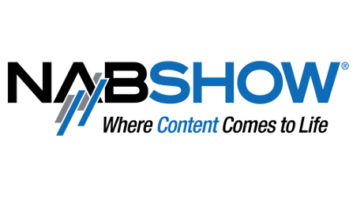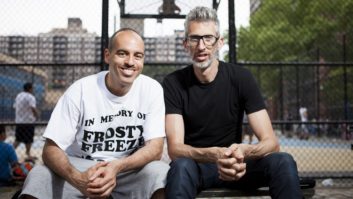
WASHINGTON — Sam Matheny is NAB’s new executive vice president and chief technology officer. He came to the broadcast lobby in July from Raleigh-N.C.-based Capitol Broadcasting, where he had been vice president of policy and innovation. He replaces Kevin Gage, who left NAB after three years when his contract was up in May.
Matheny has guided strategic investment decisions in new media and secured patents that enabled distribution of broadcast content via the Internet, according to NAB; he also engaged North Carolina state officials in developing emergency services using the ATSC Mobile Alert System to enhance the use of broadcast airwaves in times of crisis.
The 42-year-old Matheny began his broadcasting career in radio. He holds a B.S. in broadcast communications from East Carolina University and a M.S. in technology management from North Carolina State University. Matheny is also a licensed private pilot and certified scuba dive master.
He and his wife Tamara and their teenage sons Ty and Liam had just moved to the Washington area from their home in Zebulon, N.C., when he spoke with Radio World News Editor/Washington Bureau Chief Leslie Stimson for this story in advance of the Radio Show convention in Indianapolis. This was Matheny’s first interview with a radio trade publication since joining NAB.
RW: You’ve been on the job for a few weeks now. How is it going?
Matheny: I’ve been really impressed with the team here. They are very smart and engaged; and for me, everybody’s been so supportive and welcoming. So that aspect of it has been really great. I’m just really getting to a point where I’m starting to engage with our members and that’s one of the reasons I’m really excited about the Radio Show.
RW: Are there any short- or long-term goals that you can discuss?
Matheny: I’m still in learning mode. I’m applying the “two ears, one mouth” ratio, and I’m asking questions and trying to listen a lot. A broad goal is really to make sure that we’re able to support our members from a technical standpoint in the best way possible. Now, how to accomplish that; that’s something I’ve got to listen and learn about.
RW: Are radio members discussing any particular challenges that come to mind?
Matheny: I’m just now starting to engage, so I’ll answer that question a little differently. When I was at Capitol Broadcasting, we owned several radio stations; and things we were focused on were the adoption of HD Radio and FM receivers in cellphones. From my time there, I know that those were some key issues; but I really need to engage at a much broader level.
RW: Cavell & Mertz were building a test bed to be housed at NAB. One purpose was to get lab data in order to back up drive data from the all-digital AM HD Radio testing. How is the test lab coming along?
Matheny: The test lab is up and running. As you mention, we’re working with the Cavell group and our Radio Technology Committee on test plans and gathering data. If it follows plan, the lab testing should be complete by the end of this year.
RW: How are the all-digital AM tests coming along, and do you have anything to share about that?
Matheny: What I can say is it’s pretty extensive. It’s been going well, and in addition to the lab testing, we’re also doing field testing. Thus far, seven stations have been tested in the field; we’ve got another one lined up later this fall. As you can imagine, with the lab testing and all of those field tests, there’s going to be a lot of data to be analyzed. If folks really want to get the latest information, the Radio Show is going to have a session on all-digital AM. [Ed. note: The session is Sept. 10 at 2:30 p.m.]
RW: Speaking of AM, has there been a response from BMW to NAB’s letter regarding its decision to drop AM from receivers in their i3 and i8 vehicles?
Matheny: Not yet.
RW: In the letter, NAB says it would be happy to work with BMW on the issue on its concerns about the electric motor interfering with AM reception. Would you have an idea of what that would entail? Will you put engineers on it? And have you been working with other automakers, because, for example, Ford and Toyota have electric cars …
Matheny: And Nissan does as well. We would love to engage with BMW and understand what the issues are. Because these other manufacturers have been able to address any concerns. There’s multiple ways to suppress conductive interference. We’re not really sure what issues specifically BMW is having, but it’s certainly something that … other folks have been able to overcome. [In] a larger perspective, [I would] just kind of look at it and say, “Okay, in San Francisco, the number one and number two stations — I’m guessing BMW sells a number of cars in that market — the number one and number two stations are both AM. [Ed.: AM stations KCBS and KNBR were one and two in that market as of July, according to Nielsen Portable People Meter data.] And if you look at Chicago, Atlanta, Boston, New York, Philadelphia there are heavily, heavily listened to stations — all the top five or top 10 stations there … and they’re all AM. So it’s a little baffling to me.
RW: You had mentioned that at Capitol, you were involved in the effort to get FM chips enabled in cellphones. Please tell me more.
Matheny: We applauded the NextRadio app and the effort that was put there and the application itself, and making sure that we were participating actively. That’s really it, working with TagStation and doing our part with our stations to have a great user experience.
RW: So you were doing interconnectivity, going beyond the free icon…
Matheny: What we didn’t want to have happen was folks just [having] the tuner icon. We started with that, and we’re adding the interactivity.
RW: Is NAB Labs still involved in NextRadio?
Matheny: That’s one of the things we’re excited about, and we’re very supportive of NextRadio in terms of what they’re doing in development on cellphones. Specifically, we’ve been backing their development, and that’s something that we’re working closely with Emmis and other folks to keep developing. We’re big advocates of it.
RW: So providing testing help, things like that?
Matheny: Providing financial support. We helped with development of some of the core functionality. We also helped finance some of the research around it too, with Coleman Research.
RW: They’re trying to move beyond the phone to an in-dash solution. Is NAB Labs’ money helping to support that too?
Matheny: Absolutely. We are fully supportive of NextRadio’s efforts, both on cellphones and on dashboards.
RW: You’re familiar with radio. What do you see as radio’s greatest technical challenges right now?
Matheny: My first job in broadcasting was for WETC 540 AM, a 10,000-watt station in the Knightdale, Wendell, Zebulon area of North Carolina … some 20 miles east of Raleigh. Lew Parrish was the owner. It was a southern gospel and classic country station. I would go in on weekends and do everything from power the station on — I’d turn on the transmitter — to disk jockey to cart machine, production, answering the phones … so I’ve worked with radio for awhile.
My first job with Capitol Broadcasting was in their radio group. I was building websites for the North Carolina News Network, the Southern Farm Network as well as their Winston Cup Today Racing Network and other sports networks. I really enjoyed working in radio in all those capacities.
Looking at today, I reflected a little bit back on what our focus was at Capitol, but I think that continuing to work on the FM chips is something that we are going to need to do. Other than that, I’m still in learning mode. I’m going to be talking to a lot of the industry players and seeing where NAB can help from a technology perspective and combine that with my background to set a course.
RW: And turning on the transmitter in the morning … that’s hard to get up that early. Was that an AM daytimer?
Matheny: Yes it was. I had to be on the air at 6 in the morning and I ran the board and did all the stuff after I powered on the station until noon. At that time, the station was leasing its time to Hispanic broadcasters. Sometimes if they were running a little late I’d have to do the Hispanic sign-on as well, so I learned to do that.
RW: You have a background that involves experience with EAS both in North Carolina and being on the FCC advisory committee, the Communications Security, Reliability and Interoperability Council. What are your thoughts as to how radio alerting can be improved?
Matheny: Radio is an incredibly important part of emergency alerting in the U.S. and around the world, and I think the more places radio can be received, the better we will be in times of disaster and emergency. That rolls back into FM receivers in cellphones. If you look at the capability of cellphones today, the alerting that you’re able to get through a WEA alert is 90 characters of text. It usually says something to the degree of “check local media” … The more cellphones that are enabled with FM tuners, the more you’re going to be able to have direct access to local media, with a better battery performance and without taxing the cell network infrastructure. We’re working with the FCC and our members to make sure alerting by radio is optimized to the full extent that it can be and … very proud and serious about the role as first informers.
RW: RDS is experiencing more interest among broadcasters. What are your thoughts about how that can fit into alerting, or about how RDS can be used to get people’s attention in the dashboard in general? Did you ever do anything with RDS at your stations?
Matheny: We did. … When you ask about more engagement and more experience, that’s where I need to talk with folks; but I think that anytime you can improve the in-car experience, there’s a great opportunity. It’s something that all stations should be thinking about and executing on. RDS is, I think, one way to do that; and as these cars get smarter and smarter, with more compelling user experiences, there’s going to be opportunities, not just for RDS, but for even more compelling experiences that are akin to what’s happening in the NextRadio app.
RW: Is there anything else I should have asked you?
Matheny: You did not ask me about college football.
RW: Who do you support?
Matheny: I very much support the East Carolina University Pirates. I am a Pirate from ECU. We went 10 and 3 last year. We’re joining the American Conference, and we’re hoping we might be able to pull off an upset in one of these first few games.
RW: Are you the same, the Pirates, for college hoops too?
Matheny: I am, but we’re not as developed there.
RW: That’s okay, I was afraid you were going to say N.C. State. And no, sorry, we can’t have that!
Matheny: I am actually an ABC, which is “Anybody But Carolina” because I did go to N.C. State, and I do cheer for the Wolfpack, but my wife Tamara is from Durham, and so I’m also a Duke fan.
Leslie Stimson is Radio World news editor, Washington bureau chief and a Maryland Terrapin.
Comment on this or any story. Write to [email protected] with “Letter to the Editor” in the subject field.











